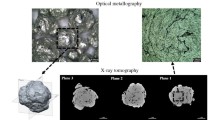The possibility of fabrication of granulate based on an alloy of the Fe – Cr – Co system with reduced (7 – 10%) cobalt content for synthesizing permanent magnets by the MIM process is considered. A multicomponent granulate composition (polyformaldehyde, high-pressure polyethylene, stearic acid, beeswax) of spherical powders of the Fe – Cr – Co alloy with reduced cobalt content is produced by gas sputtering (average particle diameter 4.2 μm, degree of polydispersity 0.75). The microstructure of the granulate and its granulometric composition are studied. The characteristics of the granulate (the mean diameter of the particles, their morphology and degree of polydispersity) exceed qualitatively the characteristics of the Catamold 42CrMo4 high-quality granulate produced by the BAFS Company.






Similar content being viewed by others
References
M. K. Niaki, S. A. Torabi, and F. Nonino, “Why manufacturers adopt additive manufacturing technologies: The role of sustainability,” J. Cleaner Prod., 222, 381 – 392 (2019).
A. V. Parkhomenko, A. R. Samboruk, S. V. Ignatov, et al., “Development of binding substances in granulates for the MIM process,” Vest. Smarsk. Gos. Univ., Ser. Tekh. Nauki, No. 2, 91 – 98 (2013).
D. F. Heaney (ed.), Handbook of Metal Injection Molding, Woodhead Publishing (2018), 636 p.
R. M. German and A. Bose, Injection Molding of Metals and Ceramics, Metal Powder Industries Federation (1997), p. 413.
J. Tian, S. Tao, X. Qu, and S. Shang, “2:17-type SmCo magnets prepared by powder injection molding using a water-based binder,” J. Magn. Magn. Mater., 320(17), 2168 – 2117 (2008).
S. Zhang, J. Tian, X. Qu, and S. Tao, “Antioxidation study of Sm(Co, Cu, Fe, Zr)z-sintered permanent magnets by metal injection molding,” J. Rare Earths, 24(5), 569 – 573 (2006).
S. H. Lee, W. Lee, W. Y. Jeung, and T. J. Moon, “Properties of anisotropic Nd(Fe, Co)B type sintered magnets produced by powder injection moulding,” Powder Metall., 41(3), 185 – 188 (1998).
T. Hartwig, L. Lopes, P. Wendhausen, and N. Ünal, “Metal injection molding (MIM) of NdFeB magnets,” EPJ Web Conf., 75, 04002 (2014).
G. Y. Chin, “New magnetic alloys,” Science, 208(4446), 888 – 894 (1980).
M. Yamashita, Sintered Fe – Cr – Co Type Magnetic Alloy and Method for Producing Article Made Therefor, Patent US4601876A United States, filed 14.12.2012, date of Patent 22.06.1986.
H. Kaneko, M. Homma, and K. Nakamura, “New ductile permanent magnet of Fe – Cr – Co system,” AIP Conf. Proc., AIP, 5(1), 1088 – 1092 (1972).
S. Sugimoto, H. Satoh, M. Okada, and M. Homma, “Evolution process of 〈100〉 texture in Fe – Cr – Co – Mo permanent magnets,” Mater. Trans., JIM, 32(6), 557 – 561 (1991).
A. S. Ustyukhin, A. B. Ankudinov, V. A. Zelenskii, et al., “Improvement of magnetic properties by hot rolling of sintered powder alloy in the Fe – Cr – Co system,” Dokl. Phys. Chem., 476(2), 193 – 196 (2017).
G. F. Korznikova, “Application of combined loading schemes for forming an ultrafine-grained structure in hard magnetic alloys of the Fe – Cr – Co system,” Fiz. Mezomekh., 20(4), 63 – 68 (2017).
M. L. Green, R. C. Sherwood, and C. C.Wong, “Powder metallurgy processing of CrCoFe permanent magnet alloys containing 5 – 25 wt.% Co,” J. Appl. Phys., 53(3), 2398 – 2400 (1982).
A. A. Shatsov, “Powder materials of the Fe – Cr – Co system,” Metalloved. Term. Obrab. Met., No. 4, 17 – 20 (2004).
V. V. Sergeev and T. I. Bulygina, Hard Magnetic Materials [in Russian], Énergiya, Moscow (1980), 224 p.
A. V. Parkhomenko, A. P. Amosov, A. R. Samboruk, et al., “Development of domestic powder granulate with polyformaldehyde-base binder for the MIM technology,” Izv. Vysh. Uchebn. Zaved., Poroshk. Metall. Funkts. Pokr., No. 4, 8 – 13 (2015).
Author information
Authors and Affiliations
Corresponding author
Additional information
Translated from Metallovedenie i Termicheskaya Obrabotka Metallov, No. 8, pp. 25 – 30, August, 2020.
Rights and permissions
About this article
Cite this article
Gavrikov, I.S., Chernyshev, B.D., Kamynin, A.V. et al. Fabrication of Granulate from a Fe – Cr – Co Alloy with Reduced Cobalt Content for Synthesizing Permanent Magnets by the MIM Process. Met Sci Heat Treat 62, 513–517 (2020). https://doi.org/10.1007/s11041-020-00594-1
Published:
Issue Date:
DOI: https://doi.org/10.1007/s11041-020-00594-1




